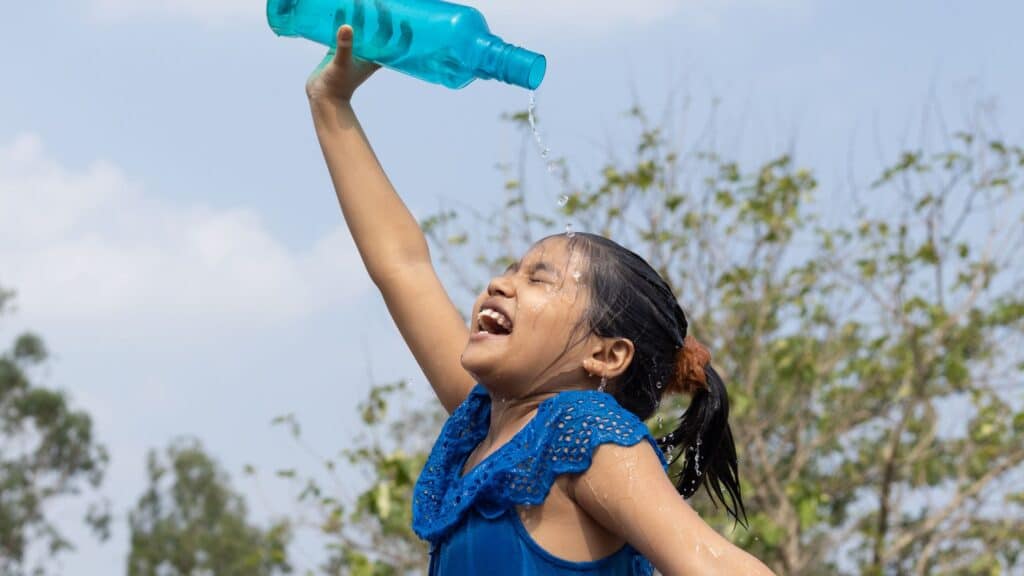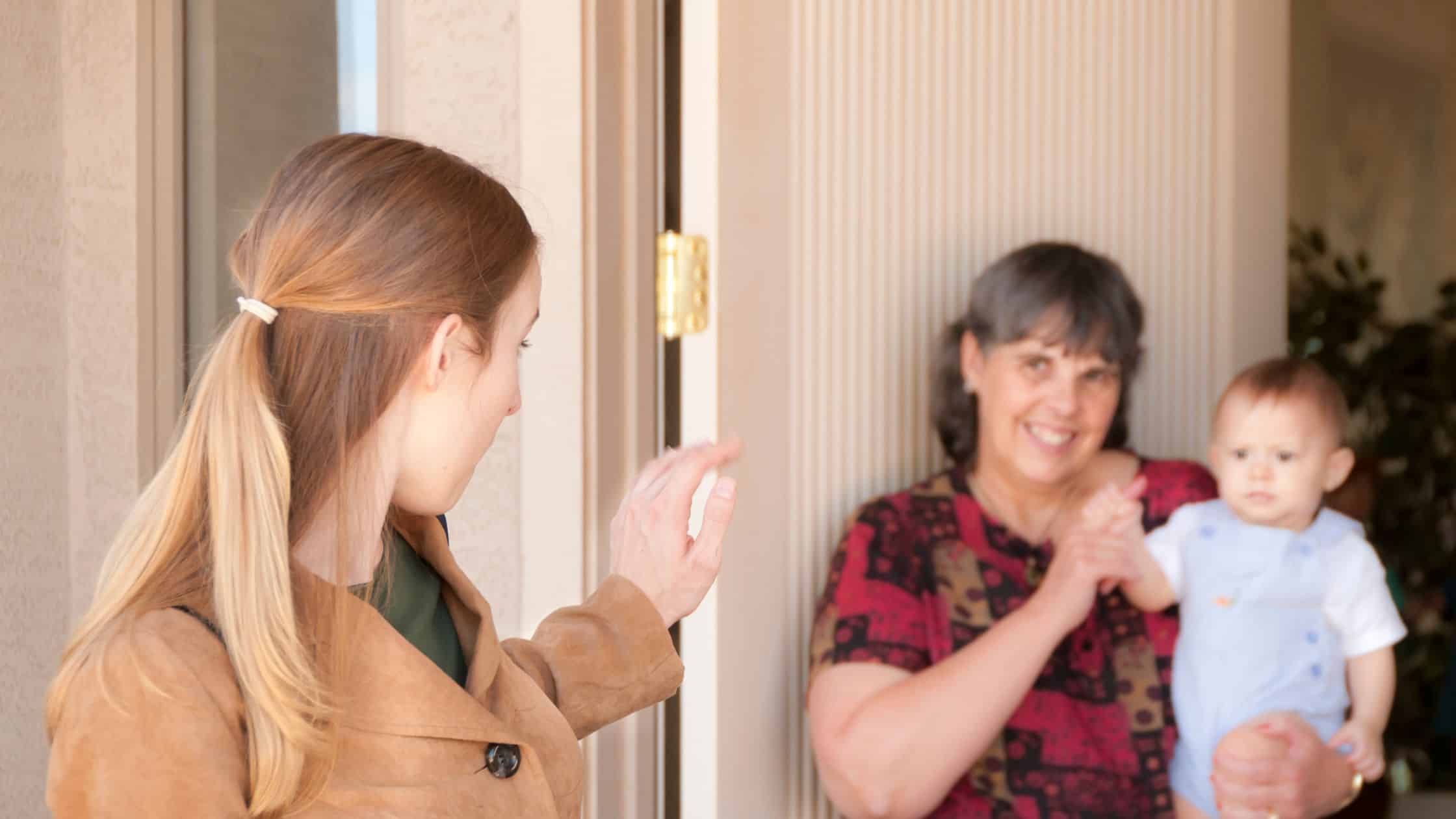What caregivers often miss and when to know it’s a medical emergency
Summer is the season of popsicles, sprinkler runs, and sun-soaked adventures. But rising temperatures can bring real risks, especially for little ones. While most kids can handle hot days just fine, heat exhaustion in kids is more common than many realize and it can escalate quickly if not caught early.
At Hello Nanny!, our goal is to educate and empower parents and caregivers with practical, evidence-based information. As a registered nurse and mom, I know how important it is to recognize the signs of heat-related illness early. When you know what to look for—and what to do—you can respond with calm confidence and help keep kids safe all summer long.
Studies show thousands of children are treated each year for heat-related illnesses—including heat exhaustion and heat stroke—especially during outdoor activities in warm or humid conditions. Whether you’re a parent, nanny, or another trusted caregiver, staying vigilant and prepared is key to keeping kids safe and thriving all summer long.
Heat Exhaustion in Kids vs. Heat Stroke: What’s the Difference?
Let’s start with the basics: heat exhaustion and heat stroke aren’t the same thing. They’re two points on a spectrum of heat-related illness—one far more dangerous than the other.
Heat exhaustion happens when the body overheats and begins to struggle to cool itself down. It’s serious, but typically treatable with prompt action like rest, hydration, and cooling measures. Symptoms may include:
- Flushed skin
- Excessive sweating
- Fatigue or dizziness
- Headache
- Nausea or vomiting
- Cool, clammy skin
- Muscle cramps
If left unaddressed, heat exhaustion can progress to heat stroke: a true medical emergency. Heat stroke occurs when the body’s temperature rises rapidly (often above 104°F) and its natural cooling system fails. At this point, urgent medical treatment is needed to prevent brain damage, organ failure, or death.
Red flags for heat stroke in kids include:
- Hot, dry skin (no longer sweating)
- Confusion or slurred speech
- Loss of consciousness
- Seizures
- Rapid pulse
- Vomiting or inability to drink fluids
- Body temperature of 104°F or higher
The key takeaway? Recognizing heat exhaustion early and acting quickly can stop a dangerous situation from getting worse.
Related: How a Summer Nanny Can Help You Reclaim the Season
Subtle Signs of Heat Exhaustion
One of the most challenging parts of identifying heat exhaustion in kids is that the early signs can look a lot like normal summertime behavior. Flushed cheeks, sweating, thirst, and even crankiness are common when kids are playing hard in the heat. But when these signs show up alongside a child who just doesn’t seem like himself, it’s time to pay closer attention.
Young children are especially vulnerable because they can overheat quickly and may not recognize or communicate what their bodies need. That’s why it’s important to step back and look at the bigger picture.
Here’s what to watch for:
- A child who suddenly seems unusually tired or irritable
- Complaints of a headache or tummy ache
- Trouble focusing or responding normally
- Skin that feels clammy or unusually hot
- Nausea, lightheadedness, or vomiting
- A sudden change in energy or mood that doesn’t bounce back with rest
In babies and non-verbal toddlers, keep an eye out for:
- Fewer wet diapers than normal
- Unusual fussiness or trouble settling
- Rapid breathing
- Refusal to feed
- Difficulty waking or seeming overly sleepy
- A sunken soft spot (fontanelle)
Even if just one or two of these signs are present, especially in the context of heat exposure, it’s best to act quickly. Cooling down early can prevent symptoms from worsening and give kids a chance to rest, rehydrate, and recover before things escalate.
Related: Nanny Responsibilities: A Comprehensive Overview for Parents
Evidence-Based Cooling Strategies: What to Do in the Moment
If you notice signs of heat exhaustion in a child, the most important thing you can do is act quickly but calmly. According to the Centers for Disease Control and Prevention (CDC) and the American Academy of Pediatrics (AAP), early intervention can stop heat exhaustion from progressing into heat stroke, which is a medical emergency.
Here’s what to do, step by step:
1. Get the child out of the heat
Move them indoors to an air-conditioned space, or into the shade if you’re outside. If you’re at a park or on the go, a shaded stroller, covered rest area, or even sitting under a tree can help.
2. Encourage rest
Have the child lie down and stop any physical activity. Rest helps the body cool down and recover.
3. Begin active cooling
Do one or more of the following:
- Remove excess clothing, especially hats and socks.
- Apply cool (not ice-cold) wet cloths to the skin.
- Use fans or gentle fanning to promote evaporative cooling.
- Mist the skin with water or sponge the body with a cool, damp cloth.
- If available, use a spray bottle or place the child near a fan while misting their skin with water.
4. Offer fluids
Encourage small, frequent sips of water or an electrolyte drink. Avoid sugary or caffeinated beverages, which can worsen dehydration.
Note: If the child is vomiting or unable to keep fluids down, stop offering drinks and seek medical care immediately.
5. Stay with the child and monitor
Watch for signs of improvement: cooling of the skin, return of normal energy or mood, and ability to tolerate fluids. If symptoms don’t improve within 30 minutes, or if new symptoms appear (like confusion or vomiting), it’s time to seek medical help.
Related: How to Keep Kids Safe Around Water: Safety Tips Every Parent Needs to Know
What NOT to Do
When a child shows signs of heat exhaustion, well-meaning caregivers might accidentally take steps that can do more harm than good. Here’s what not to do.
Don’t give fluids too quickly
Encourage small, frequent sips, not gulps. Drinking too fast or too much at once—especially in kids who feel nauseous—can lead to vomiting, which worsens dehydration.
Don’t assume a child is “just tired” or “overheated from playing”
It’s easy to dismiss subtle symptoms as typical summer fatigue. But if a child doesn’t bounce back with rest and hydration or seems off in any way, it’s best to intervene.
Don’t leave a recovering child unsupervised
Even if symptoms improve, continue to monitor the child closely for at least 30 to 60 minutes. Some symptoms can return or worsen before the body fully cools and rehydrates.
Ready to hire ASAP and need support connecting with qualified candidates quickly, all without the hassle of doing it all on your own? Click here to connect with our experienced team.
When to Call 911
While most cases of heat exhaustion in kids improve with rest, fluids, and cooling strategies, it’s critical to recognize when a child’s condition has progressed to a medical emergency.
Heat stroke is the most severe form of heat-related illness, and it can develop quickly, especially in young children. When the body can no longer regulate its core temperature, systems begin to shut down. Immediate medical intervention is required to prevent permanent damage or death.
Call 911 immediately if a child:
- Has a body temperature of 104°F or higher
- Stops sweating despite hot weather
- Becomes confused, disoriented, or unresponsive
- Faints or has trouble staying awake
- Is vomiting or unable to keep fluids down
- Has rapid breathing or a racing heart
- Experiences seizures
Don’t try to “wait it out” or drive the child yourself if symptoms are severe. Paramedics can begin life-saving treatment on the way to the hospital—something even the fastest drive can’t offer.
If you’re unsure whether it’s an emergency, it’s still better to call 911 and have a professional assess the situation. No one will fault a parent or nanny for being cautious—especially when it comes to heat-related illness, where early action can make all the difference.
Prevention Strategies
Preventing heat exhaustion in kids doesn’t require drastic measures. It just takes a little planning, observation, and awareness of the day’s heat conditions. Young children can overheat quickly, but with the right habits in place, most cases of heat-related illness are entirely avoidable. Let’s review AAP recommended heat-related illness prevention tips.
Start by structuring your day with the weather in mind. When the heat index climbs, shift outdoor activities to the early morning or later evening. Midday sun—typically from 10 a.m. to 4 p.m.—is the most intense, especially during summer months. If outdoor play is unavoidable during peak heat, prioritize shaded areas and take frequent breaks to cool off. Better yet, find a local splash pad or turn on the garden hose for some cooling water play.
Lightweight, breathable clothing can also make a big difference. Dress children in one or two loose layers, choosing light colors that reflect sunlight. Keep babies cool with minimal clothing and sun protection like wide-brimmed hats or stroller shades.
Hydration is another key prevention piece. Encourage kids to drink water regularly throughout the day, not just when they say they’re thirsty. Offer small sips often, especially during outdoor play, sports, or time at the beach or pool. For infants, stick to breast milk or formula unless otherwise directed by your pediatrician.
Be especially cautious in environments known to trap heat, like parked cars, sun-exposed strollers, or unshaded play structures. Even brief exposure can be dangerous. And remember, sun protection plays a supporting role in preventing overheating, so use child-safe sunscreen, dress for the weather, and seek shade when possible.
Staying ahead of the heat helps kids enjoy their summer while keeping safety front and center.
Related: Unplugging the Nanny: A Guide to Stopping Excessive Cell Phone Use
Working Together to Prevent Heat Illness: Key Takeaways for Parents and Caregivers
Heat-related illness can be serious, but with shared awareness and a proactive approach, it’s also highly preventable. When parents and nannies stay aligned on heat safety, children can enjoy everything summer has to offer—sprinklers, sunshine, beach days, and backyard adventures—with confidence and care.
A few smart habits make all the difference: checking the heat conditions before heading outside, offering regular water breaks between popsicles and play, watching for behavior changes, and knowing when to step in and cool down. Just as important is making sure everyone on the caregiving team is in sync.
Have open conversations about how you’ll handle hot, humid days. Will outdoor time be shortened or moved to the morning? How will you keep track of hydration and rest? What symptoms are considered red flags and when should a call to the parent or pediatrician happen? If a caretaker needs to call the pediatrician, is that number readily available?
These are small but powerful conversations that build trust and consistency, so no matter who’s on duty during long summer afternoons, everyone feels prepared.
At Hello Nanny!, we believe that strong communication and shared knowledge are the cornerstones of great care. Staying informed—and staying connected—helps protect the children you love from preventable harm, while making space for the carefree joy that summer brings.
Ready to hire ASAP and need support connecting with qualified candidates quickly, all without the hassle of doing it all on your own? Click here to connect with our experienced team.



